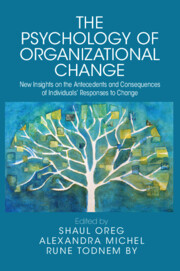 The Psychology of Organizational Change
The Psychology of Organizational Change from Part II - The Evolution of Change and Its Responses
Published online by Cambridge University Press: 28 September 2023
Organizational change is an inherently temporal phenomenon which unfolds over time. Change processes are difficult to predict, take unforeseen turns, and are often implemented sequentially. This typically causes uncertainty and ambiguity and affects employees’ appraisal of a change project and the related beliefs, expectations, emotions, and behavioral reactions. The unfolding of change processes over time is addressed in only few theoretical conceptualizations (e.g., the "change curve"). In this chapter we explore the time-related psychological aspects of organizational change. More specifically, we explore how change processes can be theoretically modeled to include a temporal perspective, how change recipients’ cognitive and emotional experiences and reactions to change evolve over time, and how individual and organizational factors influence change recipients’ experiences and reactions over time. We propose a phases model in which we describe the development of change recipients’ reactions over the course of a change project. Here, we integrate literature from the fields of organizational psychology and organizational behavior as well as change management and sensemaking.
To save this book to your Kindle, first ensure no-reply@cambridge.org is added to your Approved Personal Document E-mail List under your Personal Document Settings on the Manage Your Content and Devices page of your Amazon account. Then enter the ‘name’ part of your Kindle email address below. Find out more about saving to your Kindle.
Note you can select to save to either the @free.kindle.com or @kindle.com variations. ‘@free.kindle.com’ emails are free but can only be saved to your device when it is connected to wi-fi. ‘@kindle.com’ emails can be delivered even when you are not connected to wi-fi, but note that service fees apply.
Find out more about the Kindle Personal Document Service.
To save content items to your account, please confirm that you agree to abide by our usage policies. If this is the first time you use this feature, you will be asked to authorise Cambridge Core to connect with your account. Find out more about saving content to Dropbox.
To save content items to your account, please confirm that you agree to abide by our usage policies. If this is the first time you use this feature, you will be asked to authorise Cambridge Core to connect with your account. Find out more about saving content to Google Drive.